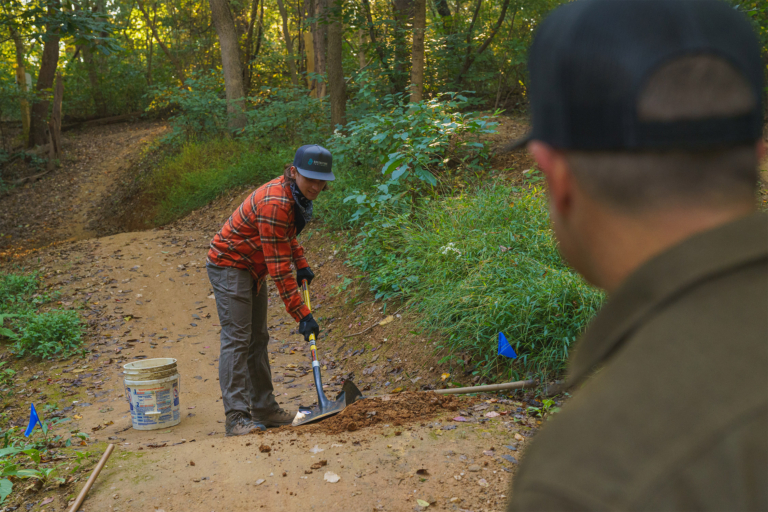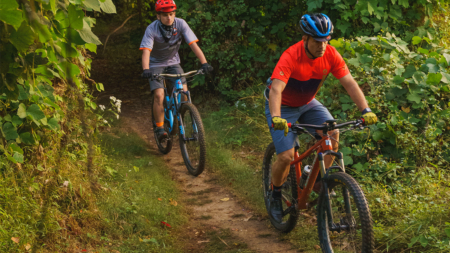At the River’s Edge
How one suburban mountain biker’s vision for a trail system reshaped a former industrial town—and turned trail building into a family tradition.
Carlo Alfano had lost track of the number of times he’d made the commute to and from his favorite mountain bike trails in the Frederick Watershed, an hour north of his home in Washington, DC. One day in 2004, he was a half hour into the return journey, somewhere between the gravel roads of northern Maryland and the bustling beltway circling the nation’s capital, and a new sign leaped at him from among the usual landmarks. “YOU COULD LIVE HERE!” it said, pointing to a quaint cluster of old brick buildings nestled along the Potomac River in Brunswick, Maryland.
The sign worked. In less than a year, Carlo had relocated his family of four from the suburbs of Washington, DC, to the sleepy, once-industrial town. By the early 2000s, Brunswick’s heyday had come and gone; once a thriving hub of the Baltimore and Ohio Railroad in the late 19th century, the industry had fallen into decline after the post–World War II recession. The town has struggled to recover ever since. Most recently, Brunswick had been rebranding itself, promoting its historic downtown as well as access to the Chesapeake & Ohio Canal and recreational activities in, on and around the Potomac River.
“We were outgrowing our 1,200 square-foot townhome after we had our second kid, so we knew we had to move,” Carlo says. “Brunswick made sense, because we were closer to mountain biking and outdoor activities and could also afford a bigger house.”
Alex Alfano was 4 years old when the family moved, and one of his first and fondest memories is biking around a neighborhood still being built around him—a construction zone with open foundations of unfinished houses, adorned with an assortment of stray building materials. His dad used the scrap pieces of plywood and two-by-fours to build ramps, jumps and features for his little shredder, who was soon biking to middle school every day, rain or shine. That’s when Carlo first noticed the 59-acre city-owned forest adjacent to Alex’s school. As any reasonable mountain biker might, Carlo wondered: “Could we build trails on this property?”
That’s as far as the average person might take the thought, but Carlo was the guy who’d moved his entire family to be closer to the trails he loved. Why not take that one step further, he thought, by building a multiuse system in his own backyard? Inevitably, his pondering coalesced into a vision and the River’s Edge trail system was born.
“Obviously, the goal was to create both a much-needed trail system for locals, but also a destination trail for the wider area,” Carlo says. “Brunswick is near both the West Virginia and Virginia borders, and there are many people who, like me, would make good use of trails that are close by.”
The idea left Carlo brimming with enthusiasm, but without experience or know-how, and lacking adequate support and materials, he was far from making it a reality. It wasn’t long before he reached out for help. The request fell on eager ears; the community was thirsty for such opportunities, and its members were quick to pitch in. The local bike shop, Three Points Cycles, helped put together a proposal to build a trail system on the dormant forest by the school, and the city council approved it in 2017. Mid-Atlantic Off-Road Enthusiasts (MORE) provided tools, guidance and fundraising support, and bikers, hikers and runners came to work on trail-building days. Local Boy Scout troops took on projects such as corridor clearing, bridge construction and building a trailside kiosk and outdoor classroom. A women’s running group routinely collected trash and debris.

Carlo Alfano doubles down on mechanical advantage, using a leaf blower to clear the Smoketown Pass trail to give himself more time for tackling other projects—and more time for riding bikes. Photo: Korey Hopkins
It took 500 hours to build the first mile of trail, all by hand, and there were plenty of things that went wrong: The weather failed to cooperate, or volunteers didn’t show up, or the day’s plan simply didn’t work out. Through it all, Carlo’s vision and determination kept the momentum rolling, both on the ground and behind-the-scenes. Karin Tome was mayor at the time (she now owns Towpath Creamery, a local ice-cream shop), and refers to Carlo as her hero. “He is one of those special people who put their money where their mouth is,” she says.
Alex spent his youth watching his father give new purpose to that chunk of city property one shovelful at a time, and he began to take on some trail-building tasks (albeit with the initial reluctance of any teenager). He wasn’t particularly keen on getting up before noon on weekends, nor on putting in hours of manual labor. His father wasn’t always thrilled, either, waiting impatiently on his son as the day grew hotter.
“I remember it was a lot of hard work just spending hours and hours in the woods, trimming all manner of trees and bushes and underbrush out of the way,” says Alex, who turned 20 this year. “But as we started building it up and more potential began to appear, I got more excited about it.”
But the tangible results and accompanying gratification far outweighed any gripes Alex may have had: Singletrack shaped by his own hand, that he and others could now ride, and a community he was influencing for the better and to which he now truly belonged. And, early mornings aside, he had a father whose example he could follow and from whom he would eventually take the reins.
“Once I started helping out with it more, I started meeting a lot of people my dad was working with, people from the city,” Alex says. “It was what I was known for in high school; between band, track and the trails, my name was out there quite a bit. It always came back to the trails in some way.”

Some kids play basketball; others build booters. Alex Alfano takes on some extracurricular activities while shaping an alternate line on Too Fast for Love, the network’s jump trail. Photo: Korey Hopkins
Carlo and Alex forged ahead with their mission. Between grants from the State Highway Administration and the City of Brunswick, they were able to hire Elevated Trail Design for the complicated, machine-built sections of the network. In October 2018, just two weeks after the completion of Phase 1, the Maryland Interscholastic Cycling League (MICL) ran its season finale race at River’s Edge. Some 200 student-athletes—including Alex—attended the event, surpassing the community’s expectations and netting an estimated revenue of $20,000 for the town in lodging, fuel, dining and retail. MICL was so impressed, it held the race there again in 2019.
Leveraging the positive effects River’s Edge had on the community, the father-son duo began advocating for and subsequently embarking on Phase 2. Alex increasingly took responsibility for this next step, continuing the work his father had started and eventually forging his own path beyond River’s Edge: as a professional builder, designing, constructing and maintaining trails for the Maryland-based GreenStone TrailCraft.
Three years after breaking ground, Carlo and Alex can now admire—and ride—the 5-mile mix of cross-country, flow and jump lines they’ve created. “With their hard work, passionate perseverance and innate ability to motivate other community members, they have helped transform a simple city woodlot into an exciting, community-minded environmental asset for everyone, in a way that will last forever,” says Karin Tome.
“I always joke that all the effort to build this system was so I could ride trails from my front door, and not have to jump in my car to do it,” Carlo says. “But I now see how important it is in promoting healthy activity in our town and neighboring communities.”
While others might take a minute to rest, Carlo and Alex are already discussing the next phase. Further expansion would require routing trail through the surrounding private properties, but thanks to their reputation in the community, they hope the landowners will be agreeable. It could be a financial boon as well; a connector between downtown Brunswick and the C&O Canal would route the trail system directly through shopping and dining areas, and finally bring it to its namesake: the edge of the Potomac River.
“It’s exciting to have the winter months to start building something new out there,” Carlo says. “We have a bunch of new perspectives on different parts of the trail. I have a vision for the thing, but it’ll be interesting to see what others have to bring to the table.”
Carlo doesn’t drive to the neighboring Frederick Watershed trails much these days. But now when he does, he passes a new sign standing above Brunswick and reads with pride: River’s Edge Trails.
Photographs were taken on ancestral lands of the Massawomeck, Manahoac and Piscataway peoples.


